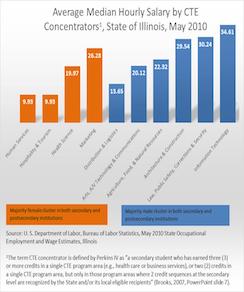Equal pay for equal work emerged as a hot-button issue recently when President Obama signed two executive orders pushing federal contractors on pay transparency and pay equity for women on federally funded programs.[1] The President’s concern reflects the fact that many of the jobs that women hold offer lower wages than similar jobs held by men having comparable education and work experience.[2] The pervasive lack of gender equity limits not only income for women but also limits the inherent wealth in the nation’s human capital.
The sixth issue of Insights into Equity and Outcomes explores the economic and social implications of gender inequity in career and technical education (CTE) and science, mathematics, engineering, and technology (STEM) fields. What factors influence entry to CTE and STEM fields of women and girls? What barriers may deter their entry and future career paths? Read Gender Equity in CTE and STEM Education to answer these questions and reflect on your own CTE environment and experiences in light of the recommendations presented for practitioners and policy makers.
[1] The White House, Office of the Press Secretary. (2014). Fact sheet: Expanding opportunity for all: Ensuring equal pay for women and promoting the women’s economic agenda [Press release]. Retrieved from http://www.whitehouse.gov/the-press-office/2014/04/08/fact-sheet-expanding-opportunity-all-ensuring-equal-pay-women-and-promot
[2] Toglia, T. (2013). Gender equity issues in CTE and STEM education. Tech Directions, 72(7), 14-17.
Carmen Gioiosa is a doctoral candidate in the Department of Education Policy, Organization & Leadership with a specialization in education administration and leadership at the University of Illinois at Urbana-Champaign. She currently works as a graduate research assistant at OCCRL.




